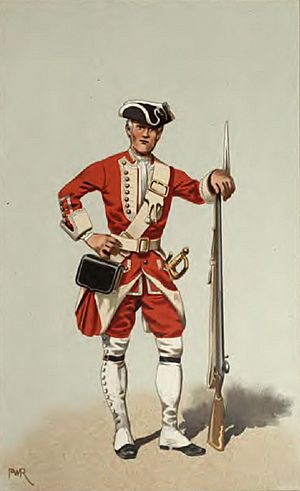Siege of Annapolis Royal (1744) facts for kids
Quick facts for kids Siege of Annapolis Royal |
|||||||
|---|---|---|---|---|---|---|---|
| Part of King George's War | |||||||
 Nova Scotia Lt. Gov. Paul Mascarene, commander of the 40th Regiment, portrait by John Smibert, 1729 |
|||||||
|
|||||||
| Belligerents | |||||||
Mi'kmaq Indians Maliseet Indians |
|||||||
| Commanders and leaders | |||||||
| Paul Mascarene John Gorham Edward How Edward Tyng |
Jean-Louis Le Loutre François Dupont Duvivier Pierre Maillard Joseph-Nicolas Gautier Joseph LeBlanc |
||||||
| Strength | |||||||
| 100 (first siege) 250 (second siege) |
300-500 (first siege) 600-700 total; 24 Acadians, 56 French soldiers, 100 Mi'kmaq from Ile Royal, 30 Mi'kmaq from Nova Scotia (second siege) |
||||||
| Casualties and losses | |||||||
| "considerable British casualties each night" (Sept.9-15) | Maliesst | ||||||
The Siege of Annapolis Royal happened in 1744. It was a big event during King George's War. This war was part of a larger conflict in Europe called the War of the Austrian Succession.
During the siege, French forces and their Mi'kmaq and Maliseet allies tried twice to take back Annapolis Royal. This town was the capital of Nova Scotia, which was then a British colony. The British, led by Governor Paul Mascarene, successfully defended the town. This siege showed how important naval support was in these battles.
Contents
Why the Siege Happened
Control Over Acadia
For many years, France and Great Britain fought over control of Acadia. This area is now known as Nova Scotia. In 1710, the British captured Port Royal, the capital of Acadia. They renamed it Annapolis Royal.
In 1713, the Treaty of Utrecht officially gave Acadia to Britain. But there were still disagreements about the exact borders. Many Acadians, who were French settlers, did not want to be ruled by the British.
War Breaks Out
In 1744, war started again in Europe. This meant fighting also began in North America. The French in New France wanted to take back Nova Scotia. They planned to attack Annapolis Royal.
The French colony of Île-Royale, now Cape Breton Island, heard the news first. A French officer named François Dupont Duvivier quickly attacked a British outpost at Canso. He captured the small British group there easily. Duvivier then planned to attack Annapolis Royal next.
First Attack on Fort Anne
Mi'kmaq and Maliseet Attack
The governor of Île-Royale, Jean-Baptiste-Louis Le Prévost Duquesnel, did not have enough soldiers. So, he asked a French priest, Jean-Louis Le Loutre, for help. Le Loutre gathered about 300 Mi'kmaq and Maliseet warriors.
On July 12, 1744, this force arrived at Fort Anne, the main fort in Annapolis Royal. They attacked, and two British soldiers were killed. But after four days, British ships arrived from Boston with 70 more soldiers. Le Loutre's force then pulled back to wait for Duvivier.
Second Attack on Fort Anne
Duvivier's Arrival
François Dupont Duvivier, who had captured Canso, led the second attack. He arrived at Fort Anne on September 6, 1744, with 200 troops. He set up shelters and used a nearby house as his headquarters.
The next morning, Duvivier approached the fort. Governor Paul Mascarene fired a cannon, and Duvivier pulled back. That night, Duvivier sent small groups to attack the fort walls. This led to fighting all night long.
Demands for Surrender
On September 7, Duvivier sent his younger brother to the fort. He carried a message asking the British to surrender. Mascarene refused. He said that more British ships were coming to help. He also promised good treatment if the French surrendered.
Duvivier gave the British 24 hours. He said he would attack at noon on September 8. However, he waited until September 9 to start the main siege.
Fighting Continues
The French troops and Mi'kmaq warriors attacked the fort walls every night. They also raided areas around the fort during the day. On September 15, Duvivier again asked Mascarene to surrender, but he refused. The fighting continued. On September 25, a British soldier was killed, and another was hurt.
Duvivier waited for weeks for French ships to arrive with more supplies and soldiers. Meanwhile, Mascarene waited for help from Boston.
British Reinforcements Arrive
On September 26, British help finally arrived. John Gorham and Edward Tyng came with 50 native rangers. These rangers were known as Gorham's Rangers. Their arrival increased the fort's defenders to about 270 men.
A few days later, Gorham led his rangers in a surprise attack on a nearby Mi'kmaq camp. This attack caused the Mi'kmaq to leave. Without their allies, Duvivier was forced to retreat. He pulled back to Grand Pre on October 5.
What Happened Next

The French learned important lessons from this siege. They realized they needed a large army with heavy cannons to capture Annapolis Royal. They also understood that they needed their navy to bring supplies and support. The French also saw that most Acadians did not want to fight against the British.
After the siege, the government of Massachusetts declared war on the Mi'kmaq. They offered a reward for the capture of any Mi'kmaq person.
Duvivier received an award called the Order of Saint Louis for his military efforts. The French tried two more times to take Annapolis Royal during the war, but they were unsuccessful.
Images for kids
-
Commodore Edward Tyng by Joseph Blackburn
-
Private, 40th Regiment of Foot, Nova Scotia, 1742






